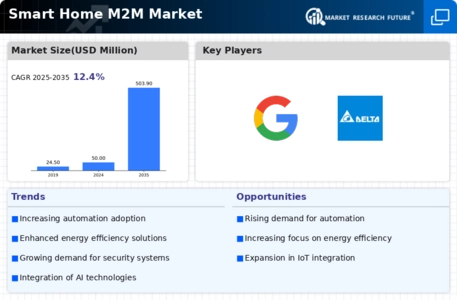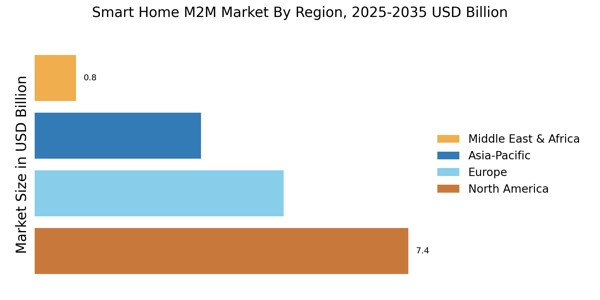Rising Consumer Demand for Automation
The Smart Home M2M Market is experiencing a notable surge in consumer demand for automation solutions. As households increasingly seek convenience and efficiency, the integration of smart devices has become a priority. According to recent data, approximately 70% of consumers express interest in automating their home environments. This trend is driven by the desire for enhanced control over home systems, such as lighting, heating, and security. The proliferation of mobile applications and voice-activated assistants further facilitates this demand, allowing users to manage their homes remotely. Consequently, manufacturers are compelled to innovate and expand their product offerings to meet these evolving consumer preferences, thereby propelling growth within the Smart Home M2M Market.
Integration of Renewable Energy Sources
The Smart Home M2M Market is being positively impacted by the integration of renewable energy sources into residential settings. As consumers become more environmentally conscious, there is a growing trend towards utilizing solar panels and energy-efficient appliances. Recent reports indicate that the adoption of solar energy in homes has increased by over 30% in the past few years. This shift not only reduces energy costs but also aligns with sustainability goals. The incorporation of smart energy management systems allows homeowners to optimize energy consumption, further driving the demand for smart home solutions. Consequently, this trend is likely to bolster the Smart Home M2M Market as it aligns with broader environmental objectives.
Growing Awareness of Home Security Solutions
The Smart Home M2M Market is witnessing a growing awareness of home security solutions among consumers. With rising concerns about safety and property protection, homeowners are increasingly investing in smart security systems. Data suggests that The Smart Home M2M Market is expected to reach USD 100 billion by 2026, reflecting a robust demand for advanced security features. Smart cameras, motion detectors, and alarm systems are becoming integral components of modern homes. This heightened focus on security not only enhances consumer confidence but also drives the adoption of smart home technologies, thereby contributing to the overall growth of the Smart Home M2M Market.
Regulatory Support for Smart Home Technologies
The Smart Home M2M Market is benefiting from increasing regulatory support for smart home technologies. Governments are recognizing the potential of smart homes to enhance energy efficiency and improve quality of life. Various initiatives and incentives are being introduced to promote the adoption of smart technologies. For instance, some regions offer tax credits for homeowners who invest in energy-efficient systems. This regulatory backing not only encourages consumer adoption but also stimulates innovation among manufacturers. As policies evolve to support smart home initiatives, the Smart Home M2M Market is likely to experience accelerated growth, driven by both consumer interest and governmental support.
Advancements in Internet of Things (IoT) Technology
The Smart Home M2M Market is significantly influenced by advancements in Internet of Things (IoT) technology. The proliferation of connected devices has transformed traditional homes into smart environments, enabling seamless communication between devices. Recent statistics indicate that the number of connected IoT devices is projected to reach 75 billion by 2025. This exponential growth facilitates the integration of various smart home solutions, enhancing user experience and operational efficiency. As IoT technology continues to evolve, it is likely to drive innovation in the Smart Home M2M Market, leading to the development of more sophisticated and interconnected systems that cater to diverse consumer needs.

















Leave a Comment